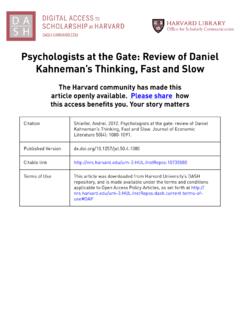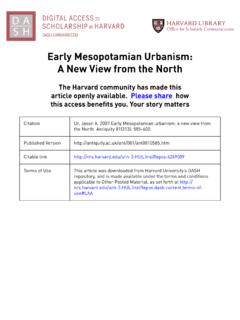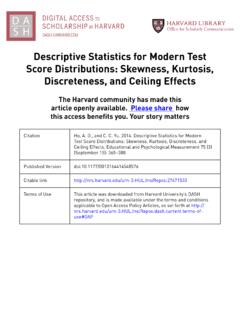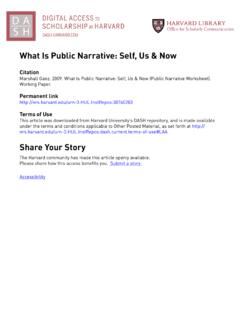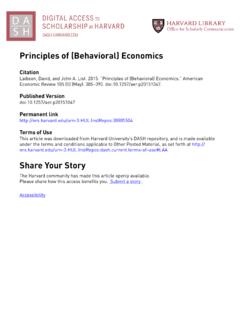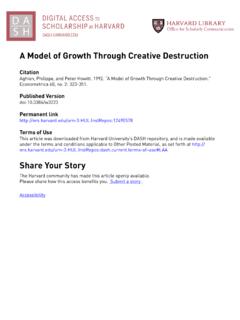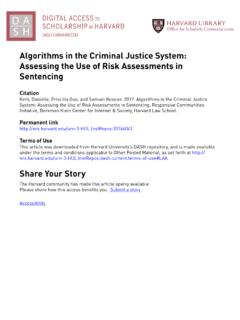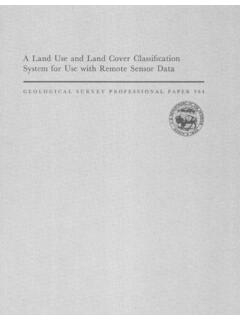Transcription of Social Dominance Orientation: A Personality Variable ...
1 Social Dominance Orientation: A Personality Variable Predicting Social and Political AttitudesCitationPratto, Felicia, James Sidanius, Lisa M. Stallworth, and Bertram F. Malle. 1994. Social Dominance orientation: A Personality Variable predicting Social and political attitudes. Journal of Personality and Social Psychology 67, no. 4: :3207711 Terms of UseThis article was downloaded from Harvard University s DASH repository, and is made available under the terms and conditions applicable to Other Posted Material, as set forth at #LAAS hare Your StoryThe Harvard community has made this article openly share how this access benefits you. Submit a story .AccessibilityJournal of Personality and Social Psychology1994, Vol. 67, No. 4, 741-763 Copyright 1994 by the American Psychological Association, Dominance Orientation: A Personality Variable Predicting Socialand Political AttitudesFelicia Pratto, Jim Sidanius, Lisa M.
2 Stallworth, and Bertram F. MalleSocial Dominance orientation (SDO), one's degree of preference for inequality among Social groups,is introduced. On the basis of Social Dominance theory, it is shown that (a) men are more socialdominance-oriented than women, (b) high-SDO people seek hierarchy-enhancing professional rolesand low-SDO people seek hierarchy-attenuating roles, (c) SDO was related to beliefs in a large num-ber of Social and political ideologies that support group-based hierarchy ( , meritocracy and rac-ism) and to support for policies that have implications for intergroup relations ( , war, civil rights,and Social programs), including new policies. SDO was distinguished from interpersonal Dominance ,conservatism, and authoritarianism. SDO was negatively correlated with empathy, tolerance, com-munality, and altruism. The ramifications of SDO in Social context are conflict and group-based inequality are pervasive inhuman existence.
3 Currently, every continent is enduring someform of ethnic conflict, from the verbal debate over multicul-turalism in the United States and Canada to civil war in Liberiaand Bosnia. Other conflicts between groups are ancient: the Eu-ropean persecution of Jews, "Holy Wars" waged by Christiansand Muslims around the Mediterranean, imperialism in SouthAmerica, and anti-Black racism in northern Africa and else-where. Regardless of the intensity of the conflict, the partici-pants justify their behavior to others by appealing to historicalinjustices, previous territorial boundaries, religious prohibi-tions, genetic and cultural theories of in-group superiority, orother such by the ubiquitous nature of group-based prejudiceand oppression, we developed Social Dominance theory (seePratto, in press; Sidanius, 1993; Sidanius & Pratto, 1993a). Thetheory postulates that societies minimize group conflict by cre-ating consensus on ideologies that promote the superiority ofone group over others (see also Sidanius, Pratto, Martin, &Stallworth, 1991).
4 Ideologies that promote or maintain groupinequality are the tools that legitimize discrimination. To worksmoothly, these ideologies must be widely accepted within a so-ciety, appearing as self-apparent truths; hence we call them hi-erarchy-legitimizing myths.' By contributing to consensual ornormalized group-based inequality, legitimizing myths help tostabilize oppression. That is, they minimize conflict amonggroups by indicating how individuals and Social institutionsshould allocate things of positive or negative Social value, suchas jobs, gold, blankets, government appointments, prison terms,and disease. For example, the ideology of anti-Black racism hasbeen instantiated in personal acts of discrimination, but also ininstitutional discrimination against African-Americans bybanks, public transit authorities, schools, churches, marriagelaws, and the penal system. Social Darwinism and meritocracyare examples of other ideologies that imply that some peopleare not as "good" as others and therefore should be allocatedless positive Social value than far, we have given examples of legitimizing myths thatenhance or maintain the degree of Social inequality.
5 Other ide-ologies may serve to attenuate the amount of inequality. Forexample, the "universal rights of man" and the view summa-rized by "all humans are God's children" are inclusive, egali-tarian ideologies that explicitly do not divide persons into cate-gories or groups. To the extent that such ideologies are widelyshared, there should be less group inequality. There are, then,two varieties of legitimizing myths: hierarchy-enhancing legiti-mizing myths, which promote greater degrees of Social inequal-ity, and hierarchy-attenuating legitimizing myths, which pro-mote greater Social Pratto, Lisa M. Stallworth, and Bertram F. Malle, Departmentof Psychology, Stanford University; Jim Sidanius, Department of Psy-chology, University of California at Los are grateful to a number of people for their diligence and creativityin this research: Erron Al-Amin, Jill Andrassy, Sahr Conway-Lanz,Nick Clements, Magda Escobar, Jack Glaser, Louis Ibarra, Kent Harber,John Hetts, Amy Lee, Johanna Jensen, John Moore, Jenn Pearson,Holly Schaefer, Margaret Shih, Stacey Sinclair, Gayatri Taneja, JackWang, and Wes Williams.
6 Bob Altemeyer, Monisha Pasupathi, VernonSchabert, Michael Mitchell, Steve Gangestad, Corinne Kosmitzki, TedGoertzel, and three anonymous reviewers provided useful comments ona draft of this concerning this article should be addressed to FeliciaPratto, Department of Psychology, Jordan Hall, Stanford University,Stanford, California Dominance ORIENTATIONG iven our theoretical postulate that acceptance of legitimiz-ing myths has significant influence on the degree of inequalityin societies, it is quite important to understand the factors thatlead to the acceptance or rejection of ideologies that promote orattenuate inequality. Social Dominance theory postulates that a1 The term myth is meant to imply that everyone in the society per-ceives these ideologies as explanations for how the world is not thatthey are false (or true). Social Dominance theory is meant only to de-scribe the Social and psychological processes that act on these ideologies,not to ascertain whether these ideologies are true, fair, moral, , SIDANIUS, STALLWORTH, AND MALLE significant factor is an individual-difference Variable called so-cial Dominance orientation (SDO), or the extent to which onedesires that one's in-group dominate and be superior to out-groups.
7 We consider SDO to be a general attitudinal orientationtoward intergroup relations, reflecting whether one generallyprefers such relations to be equal, versus hierarchical, that is,ordered along a superior-inferior dimension. The theory postu-lates that people who are more Social - Dominance oriented willtend to favor hierarchy-enhancing ideologies and policies,whereas those lower on SDO will tend to favor hierarchy-atten-uating ideologies and policies. SDO is thus the central individ-ual-difference Variable that predicts a person's acceptance or re-jection of numerous ideologies and policies relevant to way that individuals' levels of SDO may influencetheir contribution to Social equality or inequality is in the kindsof Social roles they take on, particularly, roles that either en-hance or attenuate inequality. We thus predict that those whoare higher on SDO will become members of institutions andchoose roles that maintain or increase Social inequality, whereasthose who are lower on SDO will belong to institutions andchoose roles that reduce purpose of the present research was to demonstrate thatindividual variation in SDO exists and to show that this con-struct behaves according to the theory outlined above.
8 Specifi-cally, our goals were (a) to develop a measure of SDO that isinternally and temporally reliable, (b) to show that SDO is re-lated to the attitudinal and Social role variables specified by so-cial Dominance theory (predictive validity), (c) to show that themeasure is not redundant with other attitude predictors andstandard Personality variables (discriminant validity), and (d)to show that SDO serves as an orientation in shaping first set of hypotheses we tested was derived from socialdominance theory and concerned those variables to which SDOshould strongly relate, termed predictive validity. The second setof hypotheses, termed discriminant validity, states either thatSDO should be independent of other variables or that SDOshould have predictive value in addition to the effects of theseother variables. We also hypothesized that SDO should relatemoderately to certain other Personality variables, from whichSDO is conceptually distinct.
9 The third set of hypotheses wetested concerns SDO's power to predict new Social ValidityGenderThe world over, men and women hold different roles with re-gard to the maintenance of hierarchy. Ubiquitously, men serveas military leaders and hold leadership roles in religious, Social ,political, and cultural spheres ( , Brown, 1991, pp. 110, 137).Moreover, men hold more hierarchy-enhancing attitudes, suchas support for ethnic prejudice, racism, capitalism, and right-wing political parties, than do women ( , Avery, 1988; Eisler& Loye, 1983; Ekehammar & Sidanius, 1982; Shapiro & Ma-hajan, 1986; Sidanius & Ekehammar, 1980; see review by Si-danius, Cling, & Pratto, 1991). On the basis of these generalsocietal patterns, we have predicted and shown that, on average,men are more Social Dominance -oriented than women (seePratto, Sidanius, & Stallworth, 1993; Sidanius, Pratto, & Bobo,in press).
10 We tested this hypothesis with the measure of SDOdeveloped in the present MythsEthnic PrejudiceOne of the major kinds of ideology concerning relative groupstatus is ethnic prejudice. In the United States, the most long-standing and widely disseminated version of ethnic prejudice isanti-Black racism. Therefore, we predicted that SDO would bestrongly related to anti-Black racism in the present sam-ples. In the United States, a theoretical and empirical debateabout how best to measure anti-Black racism has been con-ducted for some time ( , see Bobo, 1983; McConahay, 1986;Sears, 1988;Sniderman&Tetlock, 1986a, 1986b). Social domi-nance theory merely postulates that SDO should predict what-ever ideologies are potent within the culture at the time of mea-surement. From our theoretical viewpoint, it does not matterwhether the basis for racism is fairness ( , Kluegel & Smith,1986), genetic or biblical racial inferiority theories, symbolicracism ( , Sears, 1988), or family pathology ( , Moynihan,1965).
